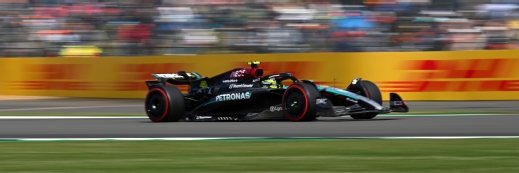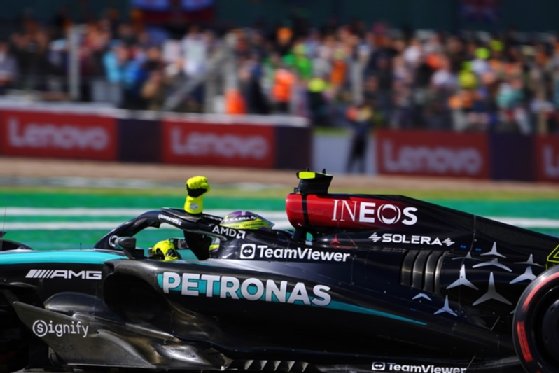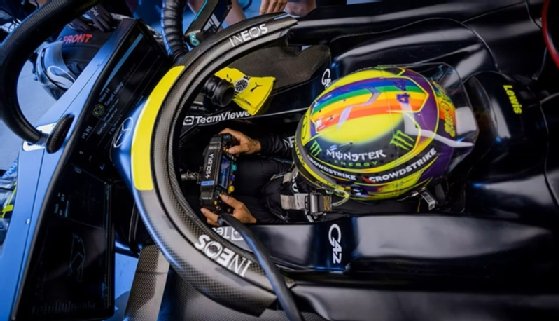
Mercedes-Benz AG
How the Mercedes F1 IT team helped Lewis Hamilton win the British Grand Prix
Computer Weekly went behind the scenes with the Mercedes-AMG Petronas Formula One team, during its victorious British Grand Prix weekend, to find out about the role of IT in beating the stopwatch
When Lewis Hamilton crossed the finish line for his emotional win in the 2024 British Grand Prix at Silverstone, there would have been a good few fist pumps from the IT team at his Mercedes-AMG Petronas Formula One team.
While fans focus on the race engineers that helped get the Mercedes car back to the top of the podium after two difficult seasons, the technology team under IT director Michael Taylor certainly played its part too.
“Technology has always played a significant role in Formula One. If you think even back to the 1950s, tech was still there – the stopwatch was the key metric, and that still exists today. Ultimately, the measure of our performance is still based on the stopwatch and that never lies,” he says.
Taylor has been in F1 since 2002 when he joined the Renault team as a network support analyst. He’s been running the IT team at Mercedes since 2020.
“I’m not sure when I entered the sport 22 years ago that I ever envisaged being the number one IT person for the top team in the sport and the top team that had dominated for so long. I don’t think it was ever on the roadmap,” he says.
“My role these days is very much less technical and is predominantly people focused. It’s a fascinating challenge. That’s the thing that keeps me coming back day after day – no two days are ever the same; this morning, I was attending [F1] regulatory meetings.”
Taylor leads a 75-strong team based out of the Mercedes F1 factory in Brackley, a few miles from the Silverstone track – a “relatively lean” group, he says, considering the depth and breadth of the technology it covers.
A typical race week for IT
The British Grand Prix was the last part of a “triple header” – three races on consecutive weekends, which placed a heavy workload on the whole team. For those in IT, it was a particularly taxing time, as head of IT operations and service management Steve Riley explains to Computer Weekly during a behind-the-scenes visit to the Brackley factory.
“A typical race week starts either on the Sunday before the race or the Monday of race week. We have two IT racks that travel around the world. They’ll either go in trucks or in planes with the rest of the kit that travels with the team. Now we’re in a triple-header and the trucks have travelled from one race on to another and on to [Silverstone]. So, we didn’t get the race trucks until Tuesday, and they were built overnight to be ready for Wednesday,” he says.
“The first thing is to get the infrastructure up and running. We effectively have a mobile datacentre that we take with us in those two IT racks. It’s got compute, network, storage – all of the typical things that you’d expect to be present in any IT environment. And then it’s about integrating that into the rest of the garage [at the race track] making sure all the network and the Wi-Fi is available in the right place and carrying out all the pre-event tests that we do from race to race.”

Riley describes each racetrack as a “multi-space environment” with all the additional demands that implies.
“We have our garages, but the pit wall is another, motorhome is another, the engineering offices are another. Wherever we go, we make sure all of that can talk to each other. Once we get to Thursday, it turns more into supporting the engineers when they arrive, then the rest of the Formula One team as they arrive into the circuit, making sure they’re up and running, that telemetry is streaming as it should be, data is available in the right places, before running [the car] on Friday,” he says.
“It’s an interesting thing to do three times over three weeks, when Formula One introduced the triple headers. But that’s what we sign up for, it’s an interesting challenge.”
Beating the stopwatch
The other key area where the IT team supports Hamilton and his fellow driver, George Russell, comes from Taylor’s key metric – the stopwatch.
“How can we solve age-old problems and challenges, but in new and inventive ways that ultimately reduce time and increase the number of cycles we can complete within a given period? The innovation in the tech industry is huge at the moment,” he says.

“It’s about making sure the organisation is ready and prepared for whatever comes next and being able to embrace it at the right time”
Michael Taylor, Mercedes-AMG Petronas Formula One
“It’s about making sure the organisation is ready and prepared for whatever comes next and being able to embrace it at the right time and to be able to maximise the value and return. Our focus really is around operational efficiency – how do we save people time? How do we use technology to reduce the manual repetitive tasks that people have to do? How can we make technology work more effectively to free up time to then hopefully reinvest in deriving a competitive advantage for the team?”
Taylor acknowledges that artificial intelligence (AI) is going to play a “very prominent part” in F1, but he’s cagey when asked to expand on its use. Most F1 teams closely protect their innovations to prevent competitors finding out how they plan to gain that extra few milliseconds around the track.
That’s especially the case for a team competing for the podium in every race. When Computer Weekly recently visited the Italian factory of the Visa Cash App RB (VCARB) F1 team – a mid-table team racing for different objectives – its executives openly discussed the use of AI and its potential for enhancing performance.
Approach to AI
But Riley is happy to explain the principles underlying his approach when it comes to AI – and his caution.
“There are lots of vendors now that have some form of AI offering which a year or two ago probably would have fallen under the banner of data science or more advanced analytics. The boundaries have been blurred a little about what artificial intelligence really is,” he says.
“But there’s certainly interest in advancements there that could serve organisationally. [Generative AI can] save people time, those repetitive tasks. There’s the ability to surface actionable insight from data within manufacturing systems and ERP, people mining [data] themselves. That’s ultimately where generative AI is beneficial. Co-pilots, code development, paired programming – there’s lots of lots of benefits there.”
He points out that those benefits are human-oriented and about saving engineering time in a factory environment – the biggest challenge in F1 is harder to tackle.
“There’s a deterministic nature to the problem that we’re trying to solve, which is: what is the optimum car configuration, on track, at a particular point in time, taking into account all of the environmental variables as well as the climatic conditions? That’s very tough to do with generative AI. If you ask generative AI the same question five times over a 10-minute period, you’ll get five different answers,” Taylor says.
Millisecond improvements
Mercedes, like all F1 teams, makes extensive of use of computational fluid dynamics (CFD), CAD/CAM systems and digital twins to model and simulate the design and engineering changes that are being made to improve the race car.
Designers and engineers are constantly trying to “mimic the aerodynamic performance of the car in a virtual world,” Taylor says.
“A lot of it is focused around those millisecond improvements. What’s the optimum front wing to have, combined with the rear wing and then all of the different setup and configurations across the car to get the driver comfortable and delivering repeatable lap times, either a single lap for qualifying or over a longer stint for a race,” he says.
“That involves a huge amount of data, data analytics, engineering, knowledge, experience and skills and lots of supporting factory-based skills to evolve that continuous lifecycle feedback loop and iterate and improve.”
The team uses a mix of in-house developed software and commercial applications, including SAP’s S/4HANA enterprise resource planning (ERP) system. One of its key software partners is remote connectivity specialist TeamViewer, whose Tensor product sits right in the heart of the trackside garage at every race.

When the drivers are sitting in the car between stints on track – typically during practice or qualifying – it’s essential to share all the key telemetry data and competitor performance information to help them improve on their next run.
This is delivered via a screen that drops down from above the car and allows the driver access to all the relevant data, and connects them to the race support room in Brackley, where engineers can share and discuss whatever information Hamilton and Russell need, including video streams and in-car communications between rival drivers and their teams.
“When the car’s in the garage, you typically have two screens that get placed on the front of the car that give the driver a view of telemetry, of weather data, video replays, competitor analysis, strategy, run plans,” explains Riley.
“We use TeamViewer to control those two screens. The performance engineers will be controlling what the driver has access to see on the screens. That can be in the middle of a qualifying session where you come into the garage to get fresh tyres or more fuel, and it can be one minute or 30 seconds even in terms of turnaround. That time is incredibly important for us to make sure we convey as much information as clearly as possible.”
Seven billion data points
During a race weekend, the cars will generate over seven billion data points from hundreds of on-board sensors. Taylor describes the car as effectively an edge computing device, transferring data back to the team’s cloud. And that data is at the heart of the strategy that can make the difference between winning and losing in every race.
“When you’re talking about the strategy system, the bulk of it is in-house written. It takes all sorts of different data feeds from our car, but also from our competitors’ cars, as well as taking GPS, timing data, weather data, and combining all that together. Our focus from a tech perspective is how can we process all of those different data points in a manner that enables the strategist sat on the pit wall or in the race support room,” says Taylor.
“How can we enable them to make the right decision in the fastest, easiest, least confrontational, frictionless way possible? Technology plays a big part in that because it’s great if you can crunch all of these different data points and datasets, but if you give the answer four laps later in the race, you’ve already missed your opportunity.
“So the ability to do all of that processing within the completion of a lap is really important – you may need to make a pit call, and you’ve got five seconds to make that call. If not, the driver is past the pit entrance and the opportunity is lost.
“It’s about using the data that you’re able to generate and visualise and view and make decisions on in the most meaningful way to hopefully optimise the result.”
Taylor may be an F1 veteran now, but he previously worked in IT for a local authority. Similarly, Riley’s background before joining Mercedes in 2016 was as a service manager in media company NBCUniversal.
Mercedes has a graduate programme and offers apprenticeships to bring in young talent, but for any petrolheads working in IT who would love the chance to experience a career in Formula One, the opportunities are there.
“I get lots of questions from people – how can I get a job in Formula One?” says Riley “They might be an infrastructure engineer or a software engineer or whatever. I tell them, just go for the job. We don’t exclusively hire people from the F1 industry. Almost everyone used to do something else before they started working here. Just go for it.”
Who knows, you might be fist pumping alongside the next Lewis Hamilton one day.
Read more about IT in sport
- Tennis and technology: How Wimbledon gave fans a GenAI experience – Computer Weekly goes behind the scenes at Wimbledon to see how tennis fans are benefiting from the latest developments in artificial intelligence.
- Atos jumps on ‘moving train’ for Euro 2024 – Atos provides the IT supporting major recurring sporting events including Uefa’s European Football Championship.
- How William Hill’s IT copes with big sporting events – The Grand National is one of those events that pushes online betting sites beyond their limits. Understanding where there are bottlenecks is key.










